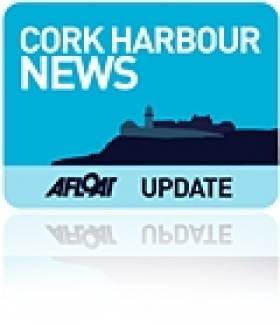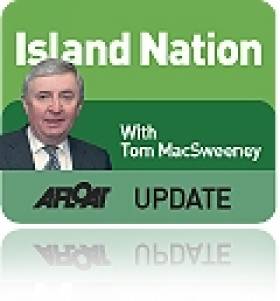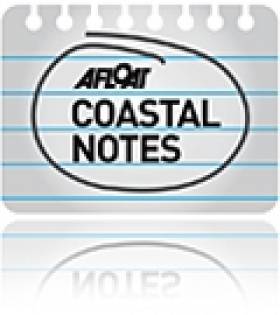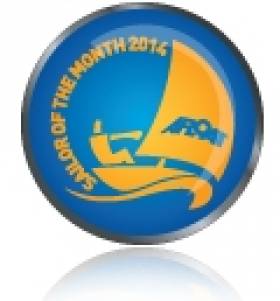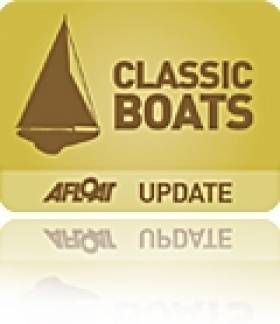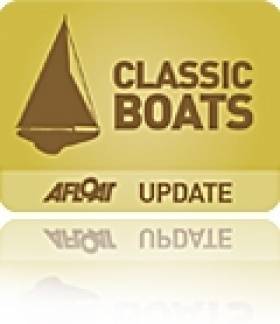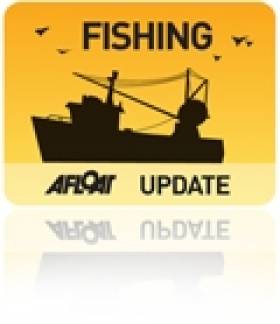Displaying items by tag: Simon Coveney
#cruiserracing – Can you successfully incorporate a full-blown National Championship into an established neighbourhood regatta? We're going to find out from June 24th to 27th, when the ICRA Nationals and the Sovereigns Cup in Kinsale are combined into one four day event, the result of the joint efforts of two sets of organisers and administrators. W M Nixon takes a look at how this situation has developed and discovers four of the top men in the marine and sailing scene have significantly different views as to how big regattas and the ICRA Nationals should be staged.
The Irish Cruiser-Racer Association emerged from an attitude of complete realism about the contemporary sailing scene in 2002. Back then, the Irish economy was starting to develop a head of steam, and people were buying potent performance-cruisers which just begged to be raced offshore. Yet changing social attitudes meant that the traditional concept of an offshore racing crew being prepared to spend seven or eight long weekends away every summer campaigning the boat in classic offshore races simply wasn't acceptable in the new world of shared family responsibilities.
But the short-lived ideal of making classic offshore racing more family-friendly was also soon seen as unattainable except for those few extra special family crews – we can all think of one or two examples - whose very uniqueness in their shared enthusiasm for rugged offshore sailing day and night only serves to emphasise that what they like doing is simply not for the majority of sailing families.
For sure, we admire them without reservation. But we know that it won't float our family's boat. For although the totality of Irish "cruiser-racers" in 2002 included several out-and-out racing machines which were vigorously campaigned inshore and offshore, the reality is that most of the fleet were the sailing equivalent of those 4x4 SUVs which block up the parking in many a leafy and affluent suburb.
Usually, the most adventurous outing such vehicles will go on is the daily school run. There's no way their loving owners plan an aggressive demonstration of their pride-and-joys supposed off-road ability. But they do seem to find it reassuring to know that if for some reason they suddenly have to go across rough terrain, the vehicle can manage it even if the driver is scared stiff. And of course, in the unlikely event that a horse-box needs to be towed – well, no problem......
So, thirteen years ago as sailing's equivalent of the SUV began to take over marinas, two leading figures in sailing administration realised that, far from changing the new increasingly family-oriented way of doing things and forcing boats well capable of going offshore to do so even if their crews didn't particularly want to, what was needed instead was a new kind of event to suit the way that most people wanted to sail with their new performance cruisers.
The late Jim Donegan of Cork, Commodore of the South Coast Offshore Racing Association, was ocean racing aristocracy – his grandfather Harry owner-skippered the 18-ton cutter Gull to third place overall in the first Fastnet Race in 1925, and consequently became one of the founder members of the Ocean Racing Club which six years later in 1931 became the RORC, while Jim himself was to go on to win many an offshore contest.
Fintan Cairns of Dun Laoghaire has given generously of his energy and time over the years to sailing both as an active participant, a race officer, and an administrator – he was Commodore of Dublin Bay Sailing Club at a period of its healthiest expansion. Like Jim Donegan, in 2002 he was hugely enthusiastic about racing boats with lids, and he loved the offshore game. Yet in the Autumn of 2002, the two of them convened a national assembly in Kilkenny in order to form an organization whose primary aim would be to create the kind of event that would be attractive to the new generation of cruiser-racer owners, people whose boats could go offshore, but preferred the nice regatta atmosphere and home-to-port-at-the-end-of-the-day format.
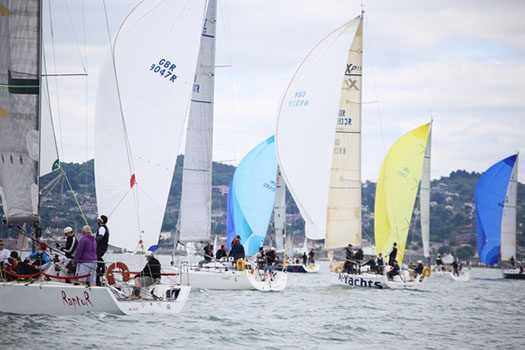
A nice regatta atmosphere, and back to port at the end of the day.....the racing in the ICRA Nationals 2014 at the Royal Irish YC in Dun Laoghaire neatly captures the purpose of the organisation as envisaged by the founders in 2002. Photo: David O'Brien
Thirty-one years earlier in 1971, the Irish Sea Offshore Racing Association had been formed by enthusiasts like Hal Sisk of Dun Laoghaire and Dickie Richardson of Holyhead on the assumption that their new organisation should be related to an area of good and extensive racing water, and for a while it worked very well. At its peak, ISORA was attracting a total entry of 107 different boats from all arts and parts into their annual season-long championship in which – if you were intending to be a serious contender – you had to think of racing at least seven events.
That meant seven weekends which, in some cases, inevitably meant leaving your home port on the Thursday and maybe not getting back until Monday morning or even later. Fine and dandy in its day, but its day didn't last too long. Maybe fifteen years in all. By then, new attitudes to family life and a tendency to concentrate one's sailing on a few big events combined with other less time-consuming smaller local events, meant that the ISORA model was no longer valid.
Yet boat numbers in ports kept increasing, so the Irish Cruiser Racing Association came into being at that November meeting in Kilkenny in 2002 to provide Irish-based regattas which, in some cases, would involve trailing the smaller boats to distant venues still on the island of Ireland, instead of sailing them many miles to others ports across the channel.
For old salts, the idea of an offshore racing association based on a land mass, and the notion of road-trailing offshore racers across that land mass to a regatta, seemed absurd. But this was only the beginning of it. For unless there was an unexpected demand for it, the new ICRA programme had no plans to include any overnight sailing except where it involved the training up an Irish Commodore's Cup team, as this was soon within ICRA's ambit.
Basically, what it meant was that ICRA's purpose was to organize an annual national championship regatta of four days at one of Ireland's main sailing centres, chosen on a rotational basis, they would also honour a "Boat of the Year", and every second year they would assemble a Commodore's Cup team.
Far from owners being faced, as they were in the old days, with the challenging demands of preparing a boat for offshore racing and then assembling an experienced crew from a panel in which the ideal number would be twice the number required to crew the boat, instead they were now offered an agreeable pattern of day sailing at some pleasant venue, and much socialising with it, while the results were efficiently calculated by ICRA's travelling road show of race administrators and number crunchers.
Yet for anyone who thought this wasn't really quite rugged enough, there was ruggedness-by-association with the Commodore's Cup campaigns. And all this went particularly well as the Irish economy went stratospheric from 2002 until 2008, so much so that at one stage Ireland actually fielded three different Commodore's Cup teams which even had the luxury of competing against each other. There's posh for you......
But it was too good to last, and ironically the economy had already fallen off a cliff in 2010 when a very serious single team Irish Commodore's Cup campaign, carefully led by Anthony O'Leary, finally won the Commodore's Cup. Also during 2010, the ICRA Nationals in late May were hosted by the Royal St George YC in Dublin Bay, which provided immediate access to the largest fleet of cruiser-racers in Ireland. Thus numbers were easily kept up to a respectable level and in all – the brutal recession notwithstanding – it was a great year for ICRA, with the 2010 Commodore Barry Rose, who had also been the Commodore's Cup Team Manager, deservedly accepting the Mitsubishi Motors "Irish Sailing Club of the Year" award after this great season.
But inevitably, things were more subdued for the next three years as the longterm ill-effects of the recession took hold. So though ICRA Nats were held in Crosshaven in 2011, Howth in 2012, and Fenit on Tralee Bay in 2013, resources were so scarce that the decision was taken not to attempt a defence of the Commodore's Cup in 2012.
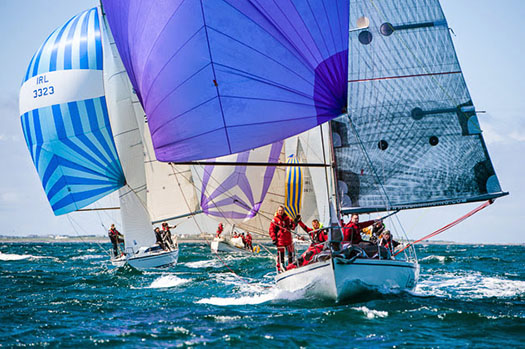
The images which came back from the ICRA Nationals 2013 in Tralee Bay suggested good sailing, but for two days the stormy weather caused a complete shut-down. Photo: Bob Bateman
When one cornerstone is removed, others are examined in more detail. The 2013 ICRA Nationals in Tralee Bay had the misfortune to coincide with a period of very unsettled weather which emphasised the fact that many of the top boats had travelled a long way by both sea and land to this gallant outpost of the Irish offshore racing scene to link up with their WIORA counterparts. But although some spectacularly sunny photos of racing in strong winds and bright sunshine emerged, the reality is that they barely had two days of viable competition as the rest of the programme was blown out in utterly miserable storm conditions.
Coming as it did at a time when the economy was barely faltering back into life, this unlucky outcome led to it being open season for suggestions as to the way ahead. There were those who wondered if people's seemingly ever-decreasing sailing time might be better used if the ICRA Nationals were combined into some established events, pointing out that a natural annual rhythm was already there with the biennial Volvo Cork Week rotating with the biennial Volvo Dun Laoghaire Regatta to provide easy access for large local fleets.
When set against the all-Ireland idealism of the founders, this was anathema to many, as the stand-alone national event, with the effort made to go anywhere in Ireland where you could find substantial local cruiser-racer fleets, was seen by some as central to the ICRA ethos.
However, things were put on hold during 2014 with a well-supported if locally-emphasised ICRA Nationals hosted by the Royal Irish YC in Dublin Bay in June, and then in July there was a mighty victory in the Commodore's Cup 2014 in a wonderful effort built around quiet background work by team captain Anthony O'Leary.

ICRA Nats 2014 in Dublin Bay saw a popular win in Class 0 for the Phelan family's Ker 36 Jump Juice from Crosshaven. Photo: David O'Brien
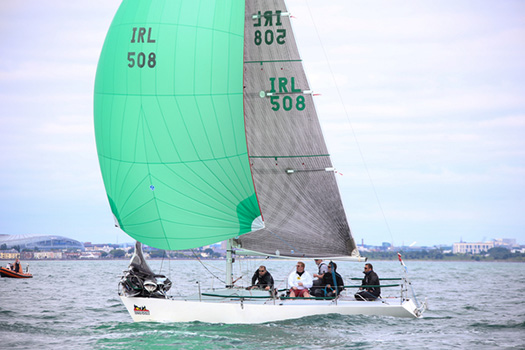
Jonathan Skerritt's vintage Quarter Tonner Quest of the host club was overall winner of the ICRA Nats 2014 at the RIYC. Photo: David O'Brien
But meanwhile, faced with the reality of the recession in sailing, ICRA's senior number cruncher Denis Kiely had quietly been putting out feelers about the possibility of combining the 2015 ICRA Nationals with Kinsale YC's biennial Sovereigns Cup regatta, which has been trundling along since 1995. By the time the great 2014 season was fully under way, it was no secret that this arrangement for 2015 was already in place, thereby guaranteeing – it was hoped – a substantial increase in numbers in 2015 and better overall value for the sailing community, while at the same time taking the ICRA Nationals to another new venue.

The perfect sailing in the 2013 Sovereign's Cup at Kinsale inspired ICRA officers to seek the link-up for the ICRA Nationals 2015 with the Sovereigns Cup 2015. Photo: Bob Bateman
At first glance, it seemed eminently sensible. But not everyone agreed. It was towards the end of an engaging interview with Commodore's Cup winner Anthony O'Leary at the end of July last summer in his beloved Royal Cork YC, just four days after he and his team had received the trophy on behalf of Ireland on the Royal Yacht Squadron lawns in Cowes, that I witnessed the first significant shot going across the bows of the good ship ICRA/Sovereigns of Kinsale.
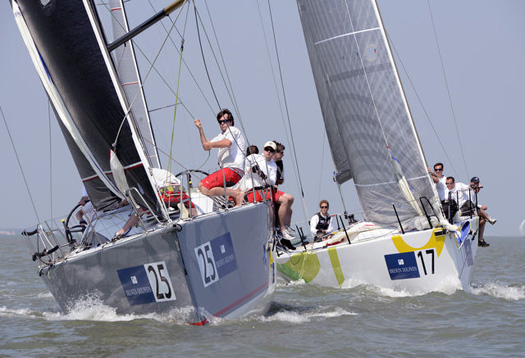
Team Captain Anthony O'Leary's veteran Ker 39 Antix hanging in there to stay ahead of a newer Ker 40 to lead Ireland to victory in the 2014 Commodore's Cup. Photo: Rick Tomlinson
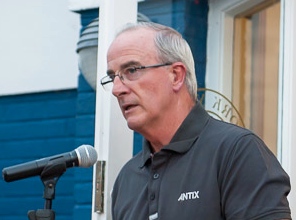
Someone whose considered opinion has to be taken seriously – Anthony O'Leary in thoughtful mood as he speaks at a reception to welcome the Commodore's Cup back to the Royal Cork YC. Photo: Bob Bateman
Anthony O'Leary was quite clear in his mind as to how the Irish cruiser-racing scene should go forward. And just as you should never get into a row with people who buy ink by the barrel, equally you wouldn't dream of openly disagreeing with someone who has just pulled Irish sailing out of the doldrums, so I just sat still and let this broadside roll over me.
"I think it's a mistake to incorporate the ICRA Nationals in the Sovereigns Cup in Kinsale....." he said bluntly. "The Sovereigns is one of my favourite regattas, but it's a friendly intimate business. While the town may have the infrastructure ashore, the marina is always crowded and I don't see how the kind of fleet they hope to attract will be comfortably accommodated there".
"Then too" he continued, "we already have two major alternating four day regattas in Dun Laoghaire and Cork Harbour. It's time to accept that sailing people are seeking to focus on fewer major events, and to give a more compact annual programme their best shot. So let's see how it would work if the ICRA Nationals simply rotated between Volvo Cork Week and the Volvo Dun Laoghaire Regatta".
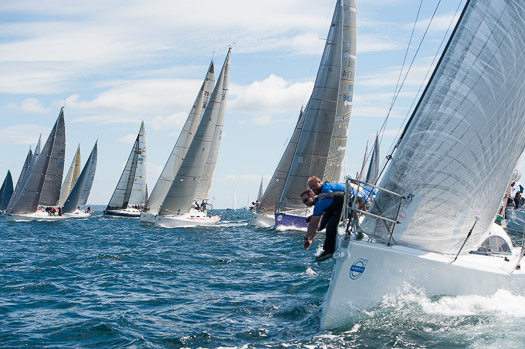
Clean close racing at Volvo Cork Week 2014. There's a line of thought that reckons this regatta could comfortably incorporate the ICRA Nationals. Photo: Bob Bateman
You can see how, in the circumstances, this idea seemed vibrant and immediately attractive. But more recently in an interview with another equally renowned sailor, Tim Goodbody who is Chairman of the Volvo Dun Laoghaire Regatta Committee 2015 there was something said which gave further pause for thought.
Tim Goodbody was totally clear in his own mind about the thinking behind the successful VDLR concept and its ability to provide viable racing for 31 different classes, and as he has helmed to victory both inshore and offshore to the highest levels, while also proving himself a master at designing courses for Dublin Bay, his views carry every bit as much weight as those of Anthony O'Leary.
"You have to remember it's a regatta, not a championship" said Goodbody. "Enjoyment of sport comes first, and the purity of fierce competition second. But of course we're going to provide the best possible starts. And the intention is to have those starts leading into the best possible courses in the conditions prevailing"
"Yet the way we see it, people should be racing just as soon as possible after leaving the harbour. There's nothing which impairs simple sailing enjoyment so much as having to wait around in a perfectly good but maybe fickle sailing breeze, hanging about in frustration while an overly-pernickety Race Officer dithers over setting the absolutely perfect start line".
In the context of the fun-filled suburban sailfest which is the VDLR, that's a perfectly reasonable approach. But is it a proper approach for something which aspires to call itself a National Championship? I rather doubt it, and there's no way the VDLR claims to be a national championship even if the numerous GP 14 Class are calling their enthusiastic participation in the VDLR 2015 the class's "Leinster Championship".
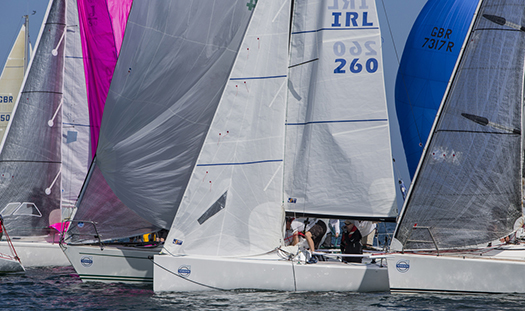
Everyone getting in everyone else's way, but that's part of the fun. The laid-back approach of the Volvo Dun Laoghaire Regatta as seen at 2013's event. Photo VDLR
For, in terms of boat size, the GP 14s will be among the smaller craft taking part in the VDLR, and they can find their own space. However, if you were campaigning a large cruiser-racer in one of the ten IRC classes which have to share the waters of Dublin Bay with 21 other boat classes during VDLR, would you expect to have your part of the event designated as the ICRA Nationals? On the contrary, if you were seriously concerned about the overall good of Irish sailing, you'd probably rightly think this was a spurious claim for what is essentially a fun event.
We were still mulling over the deeper meaning of Tim Goodbody's words in relation to Anthony O'Leary's opinions when this week another big beast in the sailing sphere, Minister for the Marine Simon Coveney no less, also launched into the choppy waters to be met with by those who would hope to rationalise the sailing programme into fewer but bigger international-standard events.
As he was speaking aboard the Naval Service's LE Eithne in Dublin's River Liffey at a reception to boost this summer's joint ICRA Nationals/Sovereigns event in Kinsale, it will be no surprise to learn that he was strongly in favour of it, so perhaps he reckons – unlike Anthony O'Leary - that Kinsale can cope with a substantial influx of visiting boats.
"Two events like this combined at the same time in one venue give extra strength" he said. "I want to see sailing in Ireland become much more ambitious in combining resources to create events which will have true international standing. This is a sport we should be really good at, both in participation and in staging events of world stature. Combining medium-sized events and regattas into one much bigger event like this one in Kinsale is going to be for the long-term good of Irish sailing in particular, and Ireland in general. The planned event is now expected to generate at least €800,000 extra income for the Kinsale area during the regatta period, while there's continuing beneficial spinoff for this harbour town which has added significance as the southern terminal and start point for the Wild Atlantic Way".

Norbert Reilly, Commodore of ICRA, with Minister for the Marine Simon Coveney at this week's reception aboard LE Eithne in Dublin to promote the combined ICRA Nats and Sovereigns Cup 2015 at Kinsale from 24th to 27th June. Photo: David Branigan
Doubtless we'll be getting spinoff of a different kind about these Ministerial views from the many people around the coast who work long and hard to keep alive those quirky little local regattas and special neighbourhood sailing and boating events which will never be major happenings of international stature, but are an essential part of the fabric of our many and varied maritime communities, and are deeply attractive for discerning visitor who shun crowds and seek out quiet enjoyment.
But as it is, aboard the Eithne we had yet another viewpoint to put into the cauldron of developing opinion, as the concluding speech was made by Nobby Reilly, current Commodore of ICRA. In a conversation with him before he made his speech, Nobby emphasised that the ICRA Nationals 2016 will be a stand-alone event once more, and he can be fairly certain about that, as the venue will be his own home port of Howth.
In the light of this, it should be remembered that in his blunt no-nonsense way, Nobby has done great work in encouraging newcomers into sailing. Earlier this week, I happened to be with some keen sailing folk from Wicklow including David Ryan – Farmer Ryan - whose remarkable Monster Project campaign of racing a Volvo 70 in Wicklow's Round Ireland Race 2014 had drawn on the efforts of Nobby Reilly and ICRA with their Let's Try Sailing campaign last May. This resulted in four wannabe sailors from remote parts of Ireland getting their first taste of the heavy metal with the Monster, and we'll see a film of it on RTE and other channels in due course, after the heroic task of cutting 147 hours of tape down to one hour has been completed.
But in the meantime, Nobby concluded the shipboard reception for this year's ICRA Nationals-with-the-Sovereigns-in-Kinsale with a spot of unexpected banter. "Maybe" says he, "maybe we should stop being concerned about trying to convince people that sailing is inexpensive. For we all know that, as it's a vehicle sport, there's bound to be basic expenditure over and above what you'd get with straightforward athletics and team sports. So maybe we should encourage people to get their kids to take up sailing on the grounds that if they come to like it, then there's no way they'll have the money to do drugs....."
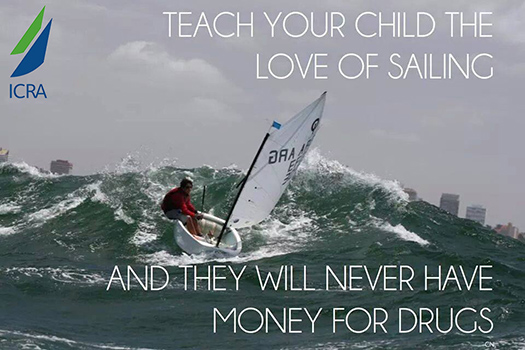
ICRA Commodore Nobby Reilly's positive response to the perceived costliness of sailing
Read also:
Should Irish Cruiser Racing (ICRA) Championships Stand Alone? (July 2013)
The Commodores' Cup – How Ireland Won It & Where It Might Go From Here (August 2014)
#haulbowline – Marine minister Simon Coveney says there has been no final decision taken on an 'Ocean Yacht Racing Hub' within the Naval Service base at Haulbowline island in Cork Harbour.
In this morning's Irish Times newspaper, marine correspondent Lorna Siggins writes that a British yacht racing consultancy has met Government agencies as part of a 'grand plan' for haulbowline island, site of a former steelworks site. The plan for the yacht base was first mooted by British solo racer Alex Thomson when he called into to Cork Harbour for repairs last April before heading across the Atlantic Ocean.
As Afloat.ie reported last October, Thomson, together with his shore manager Stuart Hosford, a Cork native, returned to the harbour and gave a public lecture about his solo sailing success that also included comment about the potential to develop the harbour site. The visit was part of an 'Innovation Week' in Cork where Cork Institute of Technology, the Irish Naval Service and University College Cork promoted the first Imerc Innovation Week.
Interest in the Haulbowline site focuses on the substantial graving dock where large yachts measuring up to over 100–foot in length or more could be lifted in an out of the water in a deep water environment with convenient access to the Atlantic.
Haulbowline has been making headlines for years because of cancer-causing residue, left over from the Irish Steel plant that once occupied the land. It has been confirmed that a cache of 500,000 tonnes of slag and toxic waste material were buried at the former steelworks. Afloat reported on the hot site in the harbour in 2011.
More in the Irish Times on the Yacht Hub story here.
Marine Minister Forecasts Wooden Boat Building Revival
#woodenboat – Marine Minister Simon Coveney is confident that wooden boat building in Ireland is going to be revived writes Tom MacSweeney.
Traditional skills have been lost and there are fears that they will disappear forever, but the Minister sounds a confident note about preserving them on the current edition of my maritime programme, THIS ISLAND NATION.
"This project is going to reinvigorate wooden boat building in Ireland again. It is going to open a new chapter for us," he says. "Hopefully multiple ports around the country will be able to build projects like this in the future. We still have great skill sets of wooden boat building available to us in Ireland which we must not lose. It is projects like this that will keep them alive and encourage a new young generation."
I recorded Mr.Coveney at Liam Hegarty's boatyard at Oldcourt near Skibbereen where the Ilen, the last traditional sailing boat of its kind, is being restored. It is the boat which the legendary Conor O'Brien had built for the Falkland Islanders who so admired his previous vessel, Saoirse, when he sailed it into those islands during his round-the-world voyage in 1923-25. Liam Hegarty's yard at Oldcourt on a bend of the road from Skibbereen to Baltimore in West Cork is one of the few remaining that specialises in wooden boat building.
The Falklanders asked O'Brien, the first Irishman to sail a round-the-world voyage to emulate the boat on which he arrived in Port Stanley. He did as they asked, having the Ilen built in Baltimore, where Saoirse was also constructed. With two Cape Clear Islanders as crew, he sailed it to the Falklands in 1926 where it worked for 70 years until Limerickman, Gary McMahon, had it brought back to Ireland in 1997:
I was the only reporter on the quayside in Dublin when it was landed there from the deck of a cargo ship, looking every bit her age of 71 years at the time. So it was a great feeling to stand on her deck in Liam Hegarty's boatshed where the restoration work has been carried out, in conjunction with the AK Ilen boat building school, initiated by Gary McMahon, the driving force of the project Such a change from the condition in which I had seen her in the Dublin docks 18 years ago.
Gary McMahon, Liam Hegarty and Minister Coveney tell the story on the programme. Gary and Liam are both confident that Ilen will be back in the water, sailing once again. She may provide opportunities for effective sail training. Several sources have provided restoration funding. More is needed for a project which, as the Minister said, can restore Ireland's resource of traditional skills.
Also on the programme you can hear the story of a submarine which sank not once, but twice, which will make you wonder whether superstition about changing the names of boats is correct. And did you know that the Dubs beat the Kingdom ... Not in football, but fishing...?
You can hear more by listening to THIS ISLAND NATION above.
#tallship – With St Patrick's Day almost upon us, the westward trek across the Atlantic in search of American benevolence and funding for worthy objectives can become a very crowded pilgrimage. Among those looking for meaningful support for their pet projects, there will likely be proponents of some sort of new Tall Ship to replace the much-mourned brigantine Asgard II, and the ketch Lord Rank, both of which foundered in 2008 to leave Ireland - north and south alike - bereft of national sail training vessels.
Since then, there have been re-groupings of those who support the admirable concept of sail training for young people. In all, there may be as many as five different bodies on the island of Ireland which now provide access to the international programme. Coiste an Asgard itself was wound up in 2011, but it was immediately re-born as the Dublin-headquartered Sail Training Ireland, the national authority which carries the imprimatur of Sail Training International, the global body which co-ordinates and regulates all sail training.
The other main organisation, often functioning in tandem with Sail Training Ireland, is the Atlantic Youth Trust. It has offices in both Dun Laoghaire and Belfast, and has as its primary objective the construction and commissioning – for all Ireland – of a Class A 40-metre three-masted barquentine. WM Nixon continues with the story.
When we carried a history and analysis of Ireland's involvement with the International Tall Ship and Sail Training movement on this site on January 17th, the immediate response was formidable, and in favour. It continues to register hits at a rate which shows that the maritime community in Ireland has a real wish to see our own proper tall ship.
To achieve this ambition, in terms of having a clearly outlined plan the Atlantic Youth Trust is way ahead. With leading personnel from many parts of Ireland on its high-powered board of Trustees and Directors, the concept - originally inspired by Enda O'Coineen and John Killeen of Galway – is already becoming very complete.
Executive Director Neil O'Hagan and other have researched globally in order to analyse the success of more than two dozen national sail training schemes, and they have concluded that the best model to learn from is the Spirit of Adventure Trust in New Zealand, which functions through training based around the barquentine Spirit of New Zealand, which at 45.2 metres in "sparred length" is steel built registering at 184 gross tons, and carries 40 trainees.
The funding concept on the capital outlay for building the new ship for Ireland will ultimately rely on a total of €15 million being put up jointly by the two governments in the interests of inter-community and cross-border co-operation. Although the current turmoil in the Northern Ireland political administration might temporarily impair the onward progress of the plan, it seems to have a certain inevitable momentum, and highly-regarded Netherlands-based Dykstra Naval Architects have been retained on the project, as have their associates at Damen Shipyards, who may supply the vessel in flatpack form for final construction in Ireland.
As to running costs, the AYT point out that it will come out of current spending, as the vessel by nature of its work will be able to tap into government funds for social welfare and other youth schemes.
Faced with such a juggernaut of ideas, energy, contacts at top government level, and sheer enthusiasm, it seems churlish to question the validity of what is, after all is said and done, a magnificent project. But there are many in Irish sailing in general and sail training in particular who are concerned about the thinking on which it is all based.
To begin with, while we all admire the maritime spirit of New Zealand, does it make sense to draw conclusions for Ireland from a successful scheme in what is essentially a very isolated island nation? Ireland may be an island nation, but it's clearly wide of the mark to describe us as isolated, and this is reflected in the pattern of tall ships visit. If just six tall ships turn up at one port in New Zealand, it's regarded as a major event. But if less than sixty tall ships turn up at this year's Tall Ships Festival in Belfast at the beginning of July, then it will be regarded as a non-event.
In other words, Spirit of New Zealand usually functions in relative isolation, so it is not sail training as we know it in Europe. In fact, she is more of a floating school cum boot camp which happens to set sails, and in order to keep her very numerous trainee complement of 40 busy, while cruising in New Zealand waters (which she does nearly all the time), she is escorted by a large rib which frequently conveys the trainees ashore for land-bound ventures which sometimes out-balance their sea time.
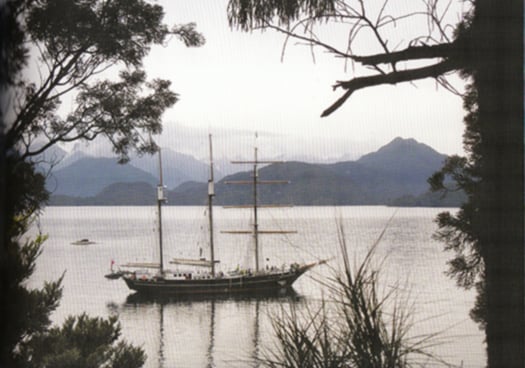
Alone, all alone.....the Spirit of New Zealand in a remote inlet on New Zealand's South Island. With forty trainees and a relatively easily-handled rig, she has a programme whch includes much shoreside activity. Photo courtesy STI
It's a very attractive programme in the New Zealand context, as they have many remote coastal areas which are virtually uninhabited and ripe for shore adventures which will not conflict with the rights of local inhabitants. But in Ireland and much of Europe such a programme would immediately meet problems, and for Ireland it makes more sense to follow the European pattern which puts an almost total emphasis on voyaging and sail training races.
Were a heavily-crewed vessel such as Spirit of New Zealand to do the European programme, there simply wouldn't be enough work for the 20 trainees on each watch to keep them happily occupied for long periods. Ideally, trainee tall ships are extremely labour-intensive for all hands, and in Europe that's the way it is done, but it needs what amounts to individual attention for each trainee.
So it's difficult to escape the conclusion that one reason for the attraction of the New Zealand scheme for the Atlantic Youth Trust is that it wins out in the numbers game. Forty young people taken out of troubled and aimless environments ashore, and sent away together on a voyage, is an impressive amount of social problems temporarily sorted in one fell swoop.
But will it be as behaviourally beneficial, in the long term, as it would be for a smaller number of people on a smaller and busier vessel? It will vary from case to case, but generally you'd reckon that the smaller more personal crew setup, with each trainee more directly involved in the sailing of the ship, would produce better results, while always remember that having as much square rig as possible is central to the concept.
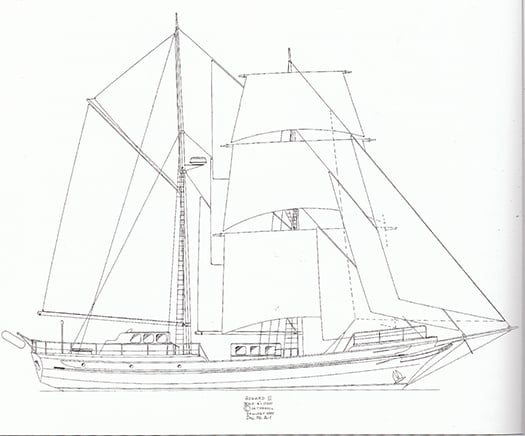
A timeless design which remains a very viable proposition for an easily managed ship which keeps her crew busy. Jack Tyrell's lines for Asgard II would lend themselves to construction in steel or even aluminium.
Ideally, to see Ireland's Tall Ship-owning reputation restored, many of us would like to see not just one newly-built replica of the 84ft brigantine Asgard II being launched, but three – one each for Cork, Dublin and Belfast. For, at the moment, the main axis of Atlantic Youth Trust activity seems to be between Dublin and Belfast. Yet as last weekend's National Annual Sailing Awards ceremony in Dublin so clearly underlined, Cork is really where it's at in terms of maritime development, and the lack of a significant Cork element seems to be a weakness of the AYT scheme.
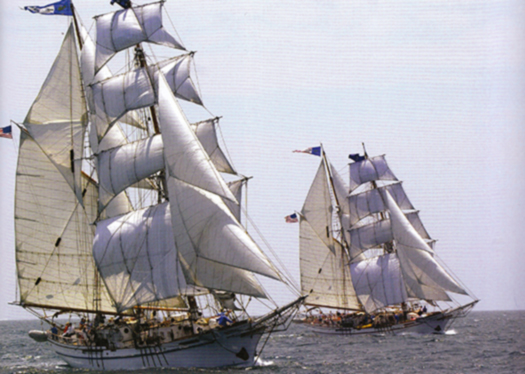
Might this be the way forward? One of our suggestions today is that Ireland really needs three Asgard IIs, based in Cork, Dublin and Belfast. We get an idea of how it might look with the two sister-ship American brigantines Exy Johnson and Irving Johnson, which are based in Los Angeles in California, where they were built in 2002.
Nevertheless, it says much for the dedication and energy of those promoting the Atlantic Youth Trust that we have the luxury of debating the validity of their plans, which have been so thoroughly developed. We may disagree with their conclusion, but it's not total disagreement – an Irish version of Spirit of New Zealand would be a very emphatic improvement on our present ship-less state, which is too much of a reflection of an ancient and negative mind-set.
Every time you see the Tall Ships gather and see how maritime countries of population comparable to Ireland, such as Norway, Denmark and Portugal, can send forth spectacularly handsome Tall Ships, it becomes a painful reminder of how the new Irish Free State increasingly turned its back on the sea.
The fact was admitted by Minister for the Marine Simon Coveney at last week's National Sailing Awards Ceremony in a speech which hinted at some very significant developments in the Irish maritime sphere in the near future.
But really, what Minister Coveney was talking about is that it is time and more for us to grow up in our attitude to the sea. When the Free State was struggling into being in 1922, the popular view was that British power was synonymous with sea power. So if you were against the sea and seafaring in all its manifestations, then you were demonstrating the purity of your patriotism through adopting what was essentially if subconsciously an anti-British stance. Childish perhaps. But we all know that's the way it was.
So despite the flurry of maritime enthusiasm which was engendered by national emergency during World War II to inspire the creation of Irish Shipping and the Maritime Inscription, what this meant was that when the underlying attitude genuinely began to change in the 1950s, a positive attitude towards the sea wasn't being built upwards from Ground Zero. It was being built from Ground Minus Thirty – the number of years that an anti-maritime attitude had been the unstated yet very real official policy.
Thus there was a period when Irish maritime enthusiasm had to be kept going almost as a secret cult, and I'd an odd reminder of this some weeks back at the annual Awards Ceremony of Sail Training Ireland. The Patron of STI is President Higgins, and the event was held – for the second year running – in the Mansion House in Dublin. Yet the very fact of the identity of their Patron, and of their event being staged in the Mansion House in the presence of Lord Mayor Christy Burke, provided such pleasure and pride for everyone in the gathering that it was a forceful reminder that, not so very long ago, seafaring was very much the poor relation in Ireland, and there were those in authority who would have happily air-brushed it out of the national picture entirely, leaving it to foreign crews to undertake the rough trades of the sea.
But thanks to those former members of Coiste an Asgard who refused to give up the vision of sail training for Ireland, even as the onset of economic Armageddon from 2008 to 2011 made any prospect of a new Asgard II a very distant vision as the government chucked the €3.8 million insurance payout into the bottomless pit of national debut, Sail Training Ireland arose like a Phoenix and set in place sail training bursaries for places on foreign tall ships, using international contacts built up during the 27 successful Asgard II years to ensure that Ireland could re-build our position at the heart of the movement.
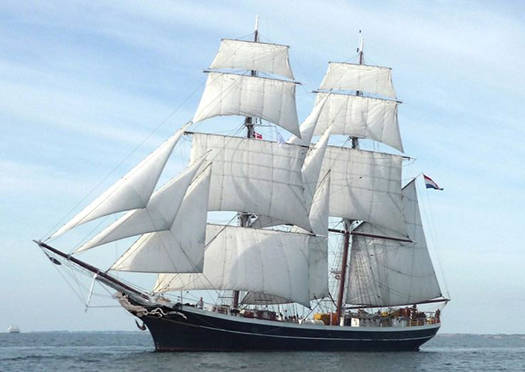
She keeps them busy....the Dutch brig Morgenster is superbly labour-intensive in the best sail training traditions. Photo courtesy STI
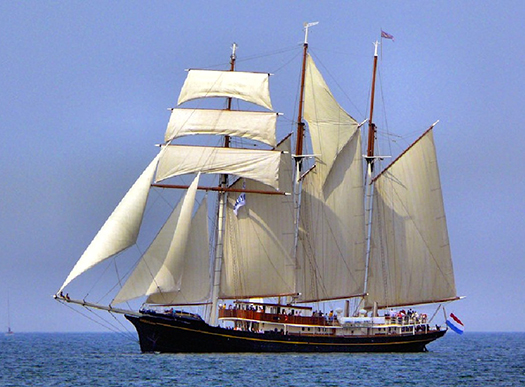
Gulden Leeuw is another of the Dutch Tall Ships which have been taking Irish trainees to sea on Sail Training International programmes. Photo: Courtesy STI
The thriving tall ships scene in the Netherlands – which has become a focal point for sail training and the Tall Ships industry for all Europe – proved the most fruitful placement area, with most Irish trainees being positioned aboard the very handsome 48 m (sparred length) brig Morgenster, which has become a familiar sight in Irish ports. Another ship well used is the three-masted topsail schooner Gulden Leeuw, a long slim craft as she is 70 m in sparred length, while that noted poster girl of Tall Ships sailing, the 56 metre three masted Dutch barque Europa, also carried Irish crew from time to time.
However, while placements on such vessels work very well, the hankering for an Irish sail training flagship is always there, and fortunately in recent years Oliver Hart's 70ft training schooner Spirit of Oysterhaven has been punching way above her weight in filling the role in gallant style with a varied programme on the Irish coast.
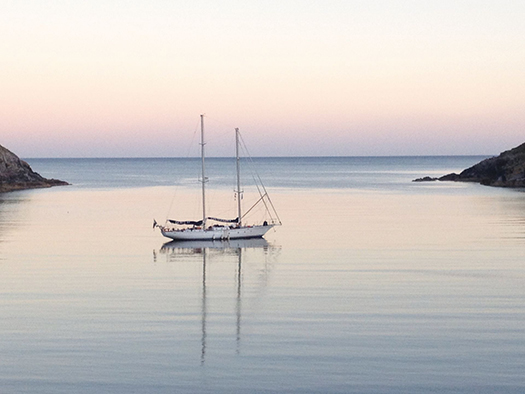
Spirit of Oysterhaven in South Harbour, Cape Clear Photo: Oliver Hart
This and much more was reflected in the Sail Training Ireland Awards Ceremony in the Mansion House, a goodly gathering which was representative not just of every possible aspect of sail training at home and abroad, but also of Irish ports which are increasingly interested in an activity which brings their ancient waterfronts vividly to life. And the progress of various ship projects was spoken for by everything from complete vessels such as the Basque Spanish schooner Atyla represented by Rodrigo de la Serna, through vessels in the making as personified by our own ketch Ilen. She has since seen her final new plank knocked ceremonially into place at Oldcourt in Baltimore, but here's an evocative video Gary MacMahon left with us of the creative planking process under way. And present too was Neil O'Hagan of Atlantic Youth Trust, whose organisation deservedly received recognition for their pioneering work towards a completely new ship.
{youtube}ZLT3D8TBbwk{/youtube}
The main awards presented in the Mansion House by STI Chairman Seamus McLoughlin, who is former Head of Operations for Dublin Port, were:
1. Trainee of the year: Andrew Crowley
2. Special Contribution Award: Turlough Kennedy
3. Special Achievement Award: Fiona Armson
4. Perpetual Asgard Award: For an outstanding contribution to, or achievement in Sail Training by an individual or group: Atlantic Youth Trust / Foroige Group of Trainees
5. Watch-leader of the Year: Sara Mason
6. Volunteer of the year: Jonathan O'Brien
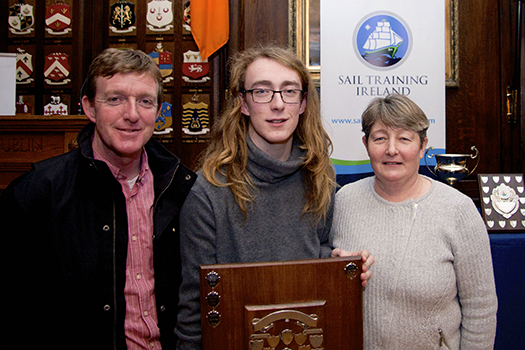
Trainee of the Year Andrew Crowley with his parents in the Mansion House
Trainee of the Year Award: Andrew Crowley
Andrew is Club Captain of the Spirit of Oysterhaven Trust. During 2014, he was instrumental in helping to organise the Club's sailing trips aboard Spirit of Oysterhaven with a special emphasis on providing opportunities for young people with disability. He helped to organise the Club's Youth in Action programme, and crewed aboard Spirit during the Irish Cruising Club's sponsored Anniversary voyage from Glandore to Glengariff with a crew of eight trainees, including several with disability. During the summer Andrew was a vital member of a short-handed crew delivering Spirit from Oysterhaven to Glandore during which he proved himself an outstanding active crew member.
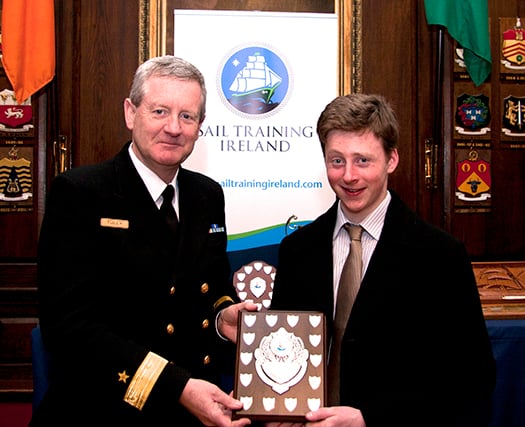
Commodore Hugh Tully, Flag Officer Commanding Naval Service, with Turlough Kennedy, who received the Special Contribution Award
Special Contribution Award: Turlough Kennedy
This year's special contribution award goes to Turlough Kennedy from the lakeside port of Scarriff in County Clare for the outstanding role he filled on the Dutch tall ship Morgenster.
To quote Michael Byrne, Director of Sail Training Ireland: "This contribution was not only recognised by us. On completion of last year's voyage Turlough - despite his limited sea going experience - was offered a crew member's berth on board the ship by the Captain. While he was not in a position last year to take up this offer for the remainder of the 2014 season, in 2015 we are delighted that Turlough will be sailing as voluntary crew on board the Morgenster. The following is a short note from the ship's Captain, Harry Muter: "Turlough sailed with us last year and he was very good good both in the sailing department as in the social processes. For his age he was surprisingly adult, patient and emphatic. And then the music, it coloured this voyage, and Turlough played a role with his complicated bagpipe and improvisation talent. Looking forward to sail with him again." " (There are no prizes for guessing that "complicated bagpipes" are Uileann Pipes).
Special Achievement Award: Fiona Armson
The special achievement award this year went to Fiona Armson for the tenacity and determination she showed by completing her 14 day voyage. Fiona found some aspects of life at sea a real challenge but despite being given several opportunities by her leaders and the crew to take on a lighter work load Fiona refused to leave her watch and pushed on.
Fiona completed her voyage having never missed a single watch or duty and, in a way that would put a smile on any sailor's face, she sailed the Gulden Leeuw into her home port of Bangor.
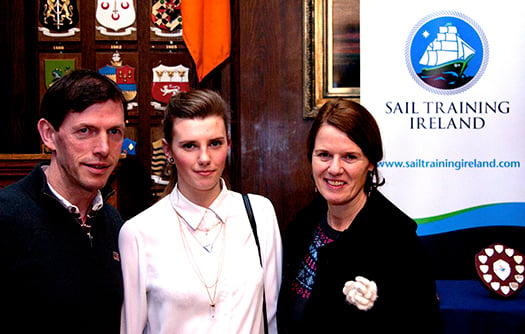
Special Achievement Award Winner Fiona Armson with her parents
Perpetual Asgard Award
Awarded to a group of four Foroige Trainees: Michael Collins, Dean Mc Keon, Brandon McDonagh, and Daniel O'Halloran,
In March 2014, four young people from Ballybane in Galway set out on a remarkable adventure, travelling half way around the world to experience the Spirit of Adventure's 10-Day Youth Development Voyage in New Zealand. Three youth workers accompanied the group for the three week trip, and one of them, Pearse O'Toole, was at the Mansion House with them. The trip was funded by a private donation and managed by the Atlantic Youth Trust and Foroige.
The group spent 10-days sailing around the magnificent Hauraki Gulf off Auckland on the barquentine Spirit of New Zealand. They adapted very well to their new surroundings as crew members and returned with fresh skills, more confidence than ever, and a new outlook on life and what is possible.
Neil O'Hagan, Executive Director of the Atlantic Youth Trust, followed this award with a presentation about the Peace and Reconciliation Fund-supported Sea-Connections scheme, and then the next award was remarkably appropriate, as it was for the Watch Leader of the Year and it went to Sara Mason for her very successful participation in an EU Youth Exchange Voyage on Gulden Leeuw.
Sara (pronounced saarah) is from the North Island of New Zealand, but now lives and studies in Dublin. She is part of the Shackleton Outdoor Adventure Management Diploma Course in Colaiste Dhulaigh in Coolock. She joined the team of youth leaders which facilitated the main voyage programme of Youth Exchange projects in May-June. As a leader on the Dutch Ship Gulden Leeuw, she cared for and facilitated a group of 40 young adults over a 14 day period. She was an outstanding support to them as a leader, and brought with her a set of skills that are unique to professionals who spend their lives working with people in the outdoor adventure industry. She also has a fantastic energy and enthusiasm and was an inspiration to the trainees and other leaders.
Volunteer of the Year Award - Jonathan O'Brien
Jonathan has become involved in a multitude of voluntary activities with Sail Training Ireland in the last year. In 2013 he volunteered as a youth leader for one of STI's youth exchange voyages for 10 days from Belfast to Dublin. In 2014 he was head-leader across youth exchange voyages with a total of 8 leaders, with at times up to 100 trainees across three ships seeking his support.
Having a background in both outdoor education and in social care, Jonathan has an exceptional set of skills that lend themselves very well to the role of leader on a tall ship, and he has now found himself "volunteered" for a position on STI's sub-committee for trainee programmes. During 2014, he also spent time on a number of ships across Europe, while somehow also fitting in a spell serving as First Mate on the Spirit of Oysterhaven. He is helping to develop on-board programmes for a number of STI's funded voyage schemes during 2015, and will also train STI's group of twelve youth leaders in April.
So the good work goes on, but the more of it there is, the more it become apparent that Ireland needs her own tall ship, and the sooner the better. A programme of international placement may work very well for those in the know, but for people down the country which are remote from maritime communities, it often takes the stimulus and sense of pride engendered by an Irish ship to make that first move afloat.
It was summed up so well by investigative academic and journalist Dr Elaine Byrne in our story about the Tall Ships on January 17th that it deserves repeating here. Usually in her line of work, Elaine Byrne takes no prisoners. But the quiet depth of feeling underlying the brief story of how the Byrne family from the deepest rural depths of County Carlow became involved in sail training has a resonance for us all today:
"I'm the oldest of seven children from a farming family on the Carlow/Wicklow border, where the household income is augmented with a funeral undertaking business attached to a pub in which I might still work on visits home. Our background is just about as far as it's possible to be from Ireland's maritime community. Yet thanks to Asgard II, I was able to take a step into the unknown world of the high seas as a trainee on board, and liked it so much that over the years I spent two months in all on board, graduating through the Watch Leader scheme and sailing in the Tall Ships programmes of races and cruises-in-company.
Down in the depths of the country, my new experiences changed the family's perceptions of seafaring. Four of my siblings then had the opportunity to sail on Asgard II. If it were not for Asgard II, my family would never have had the chance to sail, as we did not live near the sea, nor had the financial resources to do so. The Asgard II played a large role in our family life as it became a Rite of Passage to sail on board her. My two youngest siblings did not sail on Asgard II because she sank, which they much regret.
Apart from the discipline of sailing and the adventure of new experiences and countries, the Asgard II brought people of different social class and background together. There are few experiences which can achieve so much during the formative years of young adulthood".
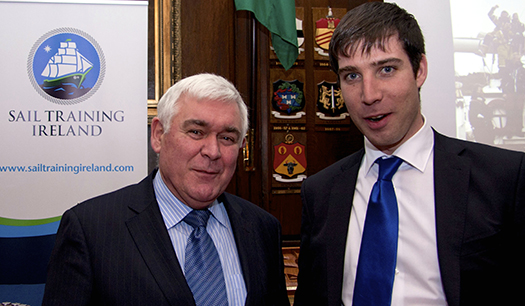
Seamus McLoughlin, Chairman of Sail Training Ireland, with Michael Byrne, Director.

Carolanna Foley, awarded a Drogheda Port Sail Training Bursary, with Seamus McLoughlin (left) and Commodore Hugh Tully
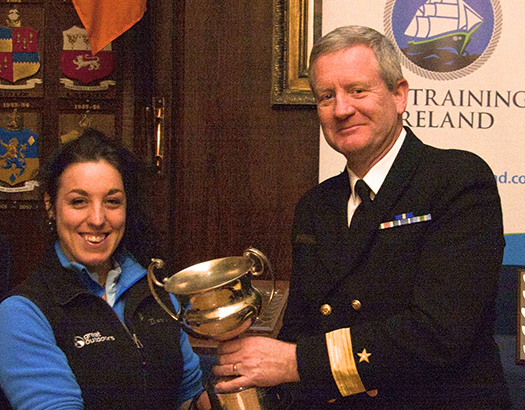
Sara Mason, Watch Leader of the Year, with Commodore Hugh Tully

Jonathan O'Brien (left) Volunteer of the Year, with Oliver Hart
- Sagres
- Tall ship
- Coiste an Asgard
- Atlantic Youth Trust
- barquentine
- Sail Training Ireland
- Sail Training International
- John Killeen
- Enda O'Coineen
- Neil O'Hagan
- Dykstra
- Damen Shipyard
- sailing
- Simon Coveney
- Lord Mayor
- Phoenix
- Spirit of Oysterhaven
- Europa
- Morgenster
- Gulden Leeuw
- Basque Spanish schooner Atyla
- Ilen
- Elaine Byrne
- Oysterhaven
- Mansion House
- Christy Burke
- World War II
The Minister for Agriculture, Food and the Marine, Simon Coveney TD, today announced the full details of a €17.8m Capital Investment Package for the ongoing development of Ireland's publicly owned fishery harbours and local harbour network .
In announcing the initiative the Minister said "I am delighted to announce the full details of my Departments €17.8m Fishery Harbour and Coastal Infrastructure Capital Programme for 2015. I have set aside €14.9m towards safety, maintenance and new development works at the six Fishery Harbour Centres at Howth, Dunmore East, Castletownbere, Dingle, Rossaveel and Killybegs, in addition to the completion of infrastructural improvement and storm damage repair works at North Harbour, Cape Clear which is also owned by my Department."
Flagship projects in the 2015 Capital Programme (see table1) include major dredging works at Dunmore East, the provision of small craft harbours and pontoons in Howth, Rossaveal and Killybegs, electrical upgrading in Castletownbere, and necessary remedial works to the main pier in Dingle. In addition, the Bull Nose Development and the Duffy's Pier storm damage repair projects at North Harbour Cape Clear are to be completed.
The Minister went on to say "I have also allocated €1.5m for a Local Authority Harbour Development and Marine Leisure programme in 2015, and as an exceptional measure I am also providing in the region of €1.4m to facilitate the completion of a number of Local Authority Storm Damage projects which were approved in 2014 as part of the Governments response to the extreme weather conditions in late 2013 and early 2014, but not completed by the Local Authorities in 2014 due to time constraints and other issues. My Department will be contacting the Local authorities regarding these schemes shortly."
The Minister concluded by saying "This is a significant level of investment in Ireland's publicly owned fisheries and local harbour network. It will continue the implementation of the Governments strategy to develop and improve the facilities at our Fishery Harbour Centres and other public harbours around our coast, benefitting a broad cohort of stakeholders including the fishing industry, seafood processing sector, other ancillary marine industries, marine tourism and leisure and the wider rural coastal communities".
Table 1- Fishery Harbour & Coastal Infrastructure Development Programme 2015
|
Location |
Project |
Department Approved Funding |
|
|
Cape Clear, Co. Cork. |
Bull Nose Development |
€900,000 |
|
|
Duffy’s Pier |
€900,000 |
||
|
Safety & Maintenance Works |
€50,000 |
||
|
Disability Access Works |
€10,000 |
||
|
Piers, Lights & Beacons |
€136,000 |
||
|
All Fishery Harbour Centres |
Safety and Maintenance |
€1,440,000 |
|
|
Howth FHC |
Traffic Management Works |
€75,000 |
|
|
Provision of Small Craft Pontoon |
€1,000,000 |
||
|
Site investigation for West Pier pontoon and Middle Pier upgrade |
€150,000 |
||
|
Upgrading Electrical System – Phase 3 |
€150,000 |
||
|
Castletownbere FHC |
Power points & Electrical Upgrade |
€350,000 |
|
|
Sanitary Facilities Works |
€90,000 |
||
|
Harbour Slipway – Phase 1 |
€400,000 |
||
|
Replacement of Water Network – Dinish Island- design |
€20,000 |
||
|
Proposed Development South Side – Dinish Island- site investigation |
€30,000 |
||
|
An Daingean FHC |
Navigation Buoys Replacement |
€130,000 |
|
|
Main Pier sheet pile Remedial Works |
€200,000 |
||
|
Harbour Workshop and Marina Users Facilities Building - Design |
€40,000 |
||
|
Upgrade Harbour Entrance |
€150,000 |
||
|
Rossaveel FHC |
Phase 2 Small Craft Harbour |
€700,000 |
|
|
Construction of New Slipway – Design Phase |
€70,000 |
||
|
Dunmore East FHC |
Harbour Office Upgrade – Phase 2 |
€200,000 |
|
|
Breakwater design |
€150,000 |
||
|
Traffic Management Plan |
€15,000 |
||
|
Dredging Works |
€6,500,000 |
||
|
Killybegs FHC |
Improvement works to Shipyard Entrances |
€40,000 |
|
|
Small Craft Harbour – Phase 2 |
€700,000 |
||
|
Provision of additional bollards |
€60,000 |
||
|
Smooth Point Pier Extension – studies and preparation: |
€175,000 |
||
|
Power Outlets - Boatyard |
€40,000 |
||
|
Local Authority |
Local Authority Harbour Development and Marine Leisure |
€1,500,000 |
|
|
Local Authority Storm Damage |
€1,400,000 |
||
Ireland's Sailing Successes Celebrated In Historic Setting
#soy – Yesterday's Afloat.ie/Irish Sailing Association annual sailing awards ceremony saw a remarkable gathering of talented boat people and their supporters and friends at the Royal College of Surgeons in Ireland in Dublin to honour the Best of the Best in company with Minster for the Marine Simon Coveney. The Sailor of the Year title went to Anthony O'Leary of Cork and our all-conquering Commodore's Cup team, while the Youth Sailor of the Year is Laser Gold Medallist Finn Lynch of County Carlow, who currently sails from the National Yacht Club in Dun Laoghaire, but started his stellar sailing career with the lakeside Blessington Sailing Club up in the Wicklow Hills.
In addition, Mayo Sailing Club was chosen from upwards of 80 training centres – both clubs and commercial ventures – as the Training Centre of the Year, while the venerable Royal Cork Yacht Club, currently led by Admiral Pat Lyons, assumes the mantle of ISA/Mitsubishi Motors Sailing Club of the Year 2015 in continuation of an informal pioneering inter-club contest - dating back to 1979 - which will resume its long-established tradition of a proper handover ceremony for the coveted ship's wheel trophy in the winner's Crosshaven clubhouse as the new season gets fully under way.
Meanwhile, Afloat's W M Nixon performed as MC in yesterday's ceremony, and in doing so he was assisted by the discovery that the venue had unexpected historic links with some of the great figures in Irish sailing history, as he now explains.
The fine building of the Royal College of Surgeons in Ireland adds a bit of real class to the west side of St Stephen's Green, and it's almost exactly at the point which most of us think of as the absolute centre of Dublin, the very heart of the city where Grafton Street winds away from the Green's northwest corner.
Yesterday afternoon it became the heart of Irish sailing too, and we struck purest gold after reflecting that the only President of the RCSI of whom we had any knowledge of a strong sailing connection was Sir Thomas Myles.
Thomas Myles (1857-1937) was one of those larger-than-life characters who completely upset our perceptions of the Victorians as self-effacing and quiet people of an overly religious disposition. A Limerick Protestant who wore his faith lightly, he was a Home Rule supporter from an early age, and while studying medicine at Trinity College in Dublin he became a university boxing champion of such continuing power that at the age of thirty he went three rounds with the legendary prize fighter John L Sullivan.
Sailing was among his many sports, and as his reputation and income grew with his success as a surgeon, so too did the size of the yachts which he sailed from the Royal Irish Yacht Club on Dublin Bay. By the 1890s he was one of the most eminent surgeons in the city, and in a contest at the turn of the century he stood as firm favourite for the election to be the President of the Royal College of Surgeons in Ireland for the period 1900 to 1902.
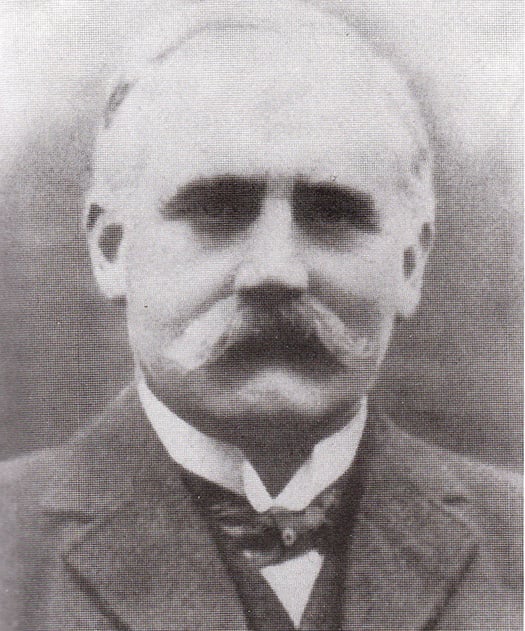
Thomas Myles around the time he was President of the Royal College of Surgeons in Ireland
But his opponent, one Dr Henry FitzGibbon, refused to accept the situation on the grounds that Myles' public involvement with the United Irish League would bring disrepute upon the college, and he went to court to argue his case that Myles shouldn't be allowed to stand for election in the first place .
Now it so happened that another keen sailing man, Walter Boyd of Howth (his son was to design the Howth 17s), was the judge who heard the case. Boyd is best known for his twelve years as a bankruptcy judge which resulted in the phrase "breaking Boyd's heart" becoming Dublinese to describe profligacy as referenced in Joyce's Ulysses. But in 1897 he had returned to more general cases, thus it was Boyd who heard the FitzGibbon/Myles case, and he threw out the plaintiff's arguments with such vigour that FitzGibbon was obliged to publish apologies and withdraw his candidature.
So when Thomas Myles became the president of the RCSI in 1900, it was an elevation which received much more than the usual attention around town. And in a style typical of the man, he set in motion the process whereby the College started to build itself the Grand Banqueting and Examination Hall, which is where the great and the good of Irish sailing were assembled yesterday.
The impressive new hall wasn't fully finished until 1904, but by that time its instigator had become Sir Thomas Myles Bt, as was the custom with retiring Presidents of the RCSI. Having seen the new building works under way, his retirement from office - though not from working as a surgeon - meant he'd more time on his hands, so he bought himself a great big ketch, the 121-ton Dorothy, which he cruised on the coasts of Europe.
But by 1910 or perhaps even earlier, he had downsized to the more workmanlike and manageable 60ft Chotah, which had been built in Brixham in Devon in the 1890s and was apparently not unlike a Brixham trawler, for the ever busy Wally McGuirk of Howth has discovered that she ended her days as an Arklow fishing boat.
The reason Wally and others are so interested in Chotah is that she is the missing link in the 1914 Howth and Kilcoole gun-runnings. We know all about the "flagship" of that event, Erskine and Molly Childers' Asgard, we know too about Conor O'Brien's ancient ketch Kelpie and have photos of her as well, and we even know a little bit about the Nugget, the McLaughlin family's boat which was the first fishing boat in Howth to be fitted with an engine.
But of the Chotah we know very little at the moment, but hope that the newfound Arklow connection will discover a photo. What is known is that when the gun-running committee sought to find a suitable vessel with auxiliary power to take over the cargo of 600 guns from Conor O'Brien's engineless Kelpie in order to land them on the beach at Kilcoole in County Wicklow, that pillar of society Sir Thomas Myles willingly agreed to bring Chotah in on the action. He and his crew took aboard the guns off St Tudwal's Island just south of Abersoch on the Welsh coast, and brought them across Channel to land at Kilcoole a few days after Asgard had made her much more high profile landing at Howth.
If you find all this insurgency activity by significant figures in Irish society a bit bewildering to comprehend in all its complexity, you ain't heard nothing yet. The Great War broke out just a few days later, and in a general mobilization Sir Thomas Myles Bt was soon appointed to being a Lieutenant Colonel in the British Army in order that he could head up a large Royal Army Medical Corps medical and surgery unit in his hospitals and in the field.
Then in November 1914 – barely three months after he had been personally involved in smuggling guns into Ireland while evading the surveillance of His Majesty's Armed Services – Sir Thomas Myles was appointed Honorary Surgeon to King George V. Yet it's said that when the 1916 Easter Rising took place, he readily found the facilities to treat any wounded rebels, and even managed to hide those on the run in the rabbit warrens of hundreds of rooms which were to be found in the great Dublin hospitals under his supervision.
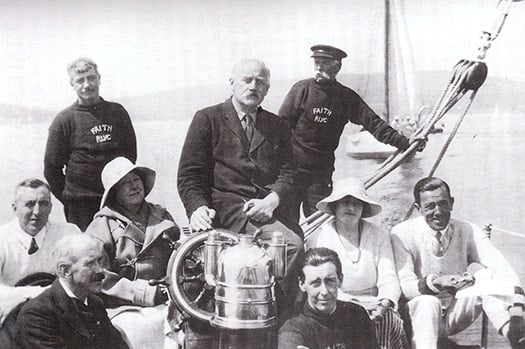
Pillar of society. Sir Thomas Myles sailing with family and friends aboard his cutter Faith in the 1920s. Photo courtesy RIYC
So if you happened to notice me looking around in some wonderment at the stately and ordered design of the Banquetting Hall in the Royal College of Surgeons yesterday afternoon while I reflected on the man who had caused this very fine room and the handsome edifice about it to be built, now maybe you'll understand why. Yet such is the complexity of Irish sailing in its myriad of forms that it's arguably all of a piece with the extraordinary lifepath of people like Sir Thomas Myles, and the ISA President's speech captured some of the problems people face in trying to administer this weird sport of ours.
The new Sailor of the Year Anthony O'Leary wasn't present for the awards as he is currently in the midst of a long-planned sailing campaign in Florida. But for the actual handover, his place was well taken by his son Robert and RORC Commodore Michael Boyd, who was co-skipper of Quokka in the successful Commodore's Cup team.
Things could have become completely surreal as the President himself, David Lovergove, wasn't at the event as his flight home from America the day before had been cancelled because of exceptionally heavy snowfalls on the US East Coast. But ISA Board Member David O'Brien of Cork of gallantly stepped up to the plate to fulfill the Presidential role, and made a fine job of delivering a speech which well encapsulates what the day was all about:
"Flag Officers, distinguished guests and fellow sailors, you are all very welcome here this afternoon. In looking out over this friendly assembly - some of whom I know very well, many of whom I know quite well, and some of whom I don't know at all but am looking forward very much to meeting – it is clearly obvious that the sailing and boating community in Ireland is one of enormous diversity.
In fact, in thinking of the sheer range and varying levels of activities afloat which we in the ISA try to represent, I am reminded of President de Gaulle's exasperated comment about the difficulties inherent in trying to govern France: "How can you administer a country" demanded the frustrated General "which has two hundred and forty-six varieties of cheese?"
Our fellow members of the Irish sailing and boating community may well think that we on the Board of the Irish Sailing Association tend to see ourselves as the big cheeses among the many varieties. Believe me, nothing could be further from the truth. Like yourselves, we could be described as the small artisan cheeses of sailing, with a strong local flavour. But it happens that it has fallen to us on the Board at this time, to undertake the task of re-shaping the Irish Sailing Association as it emerges rather bruised from the economic recession, and we need your help.
So I would ask you to be sympathetic to us in the administration of the Irish Sailing Association as we work to re-form our structures and implement our new Strategic Plan 2015-2020. It has been most encouraging the way that the Public Consultation Meetings in Dun Laoghaire, Cork and Galway in recent weeks have been so well attended, and from them we have gained very useful insights to work with you towards a productive, worthwhile and groundbreaking ISA Annual General Meeting on March 28th.
But that's another day's work. This afternoon, we are here for a celebration to honour Irish sailing and its many successes both individually and in team efforts through 2014. This function began as a thought in my mind when, during last summer, we were getting reports of fantastic results being achieved by Irish sailors and I felt that we, as the Board of the ISA, should recognize these achievements in some way. A reception was considered, then as Summer progressed and incredible achievements continued to roll in, I realized that such receptions would almost need to be held on a weekly basis.
So it was decided to wait until year end and combine the celebration of Irish sailing achievements with the presenting of the awards. Yet even that is a cause of concern. You see, in looking over the extraordinary listings for 2014, for the life of me I don't see how 2015 can even begin to match it. But as with 2014, doubtless this year will also produce some very welcome good news stories, and we look forward to the new season very much indeed, with the confidence that Ireland will continue to punch well above its weight in the world of sailing.
The structure of this afternoon's awards ceremony will help you to form a comprehensive picture of the entire Irish sailing and boating scene. Most appropriately, we will begin with the award for the ISA Training Centre of the Year, which we reckon to have been the best in 2014 from a lineup which includes an impressive 80 training facilities, run both in clubs, and as commercial ventures.
It's also worth noting that there are now 24 secondary schools in Ireland, which include sailing as a sports option in their curriculum. A while ago, I visited Schull Sailing School and was bowled over by the fact that the children in the local school select sailing as their sport of first choice, ahead of rugby, soccer, Gaelic football, hurling, hockey etc. Now that is some achievement. This is clearly a step in the right direction, and it leads us to the next part of our ceremony, the award for the ISA Youth Sailor of the Year.
Having laid the foundations, so to speak, we then move on to the announcement of the ISA/Mitsubishi Motors "Sailing Club of the Year" award. The demographics and population spread of Ireland are such that our sailing clubs play the key role in most of our sailing development, and as we had the world's first sailing club in 1720, our clubs are literally world class.
We not only invented sailing clubs, but back in 1979 we became the first sailing country in the world to have an informal "Club of the Year" competition. Since 1986, it has been sponsored by our very good friends of Irish sailing at Mitsubishi Motors.
We feel that today's national gathering is the appropriate time to announce the winner, which will be known as the Sailing Club of the Year 2015. But in time-honoured tradition, as the new season gathers pace, there will be another ceremony in the winning clubhouse for the full and final handover of the historic ship's wheel trophy, when the members can share in the successes obtained by their top competitors and administrators.
With this framework of Irish sailing clearly in place, we then conclude with the peak of achievement, the ISA/Afloat "Sailor of the Year 2014". Afloat's ownership of this award – based on Sailor of the Month winners - has a long history, going back to 1996, and it successfully highlights achievement in every area of sailing.
One month, you might get an exceptional voyage honoured, while the next month it might be a major international dinghy championship victory. The diversity is total. And just occasionally, to emphasise that we are a community, which functions afloat and ashore, the monthly award might go to someone who has given selflessly of their time for sailing administration.
The overall national award will be presented to the person who, in the judges' opinion, achieved the most notable results in, or made the most significant contribution to Irish sailing during 2014.
The boating public has had a chance to nominate their top three through an online poll, Afloat.ie got a vote too and the Sailor of the Year judges have decided the final winner.
I cannot conclude without acknowledging our sponsors. In addition to those mentioned here today – Dublin Port, Parasol and Mitsubishi Motors - I also want to thank Providence Resources for their contribution to the high performance squad. However, it is the incredible support that we receive from the Irish Sports Council that allows us to function and without whose support we would not have nearly as much to celebrate today as we have. Year after year the Sports Council continues to support sailing and behalf of Irish sailors, I thank you most sincerely".
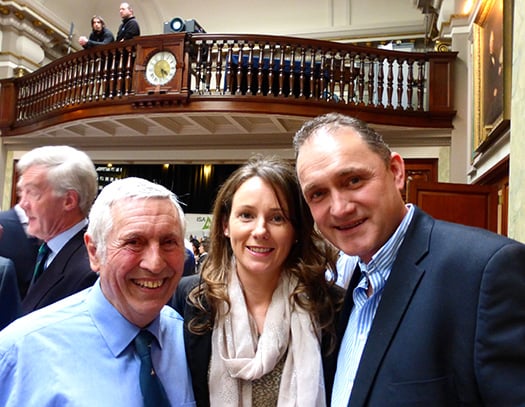
The men who raced the open ocean. At the reception in the RCSI were (left to right) Dickie Gomes (Sailor of the Month for May 2014), Caroline Coyne, and her husband Liam Coyne (Sailor of the Month for August 2014). Both Dickie and Liam have sailed short-handed Round Britain and Ireland Races with success, the former in 1982 and the latter in 2014. Liam Coyne topped the Afloat.ie online poll for 2014. Photo: W M Nixon
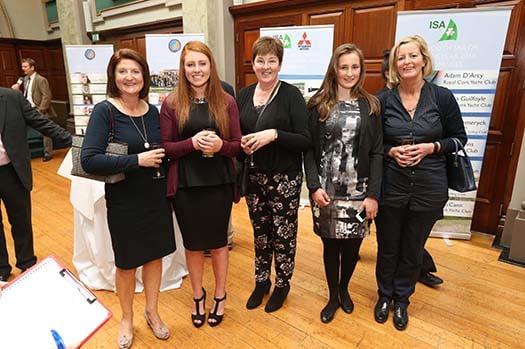
Josephine Keller, Aisling Keller, Ann Carroll, Nicole Hemeryck and Oisine Hemeryck
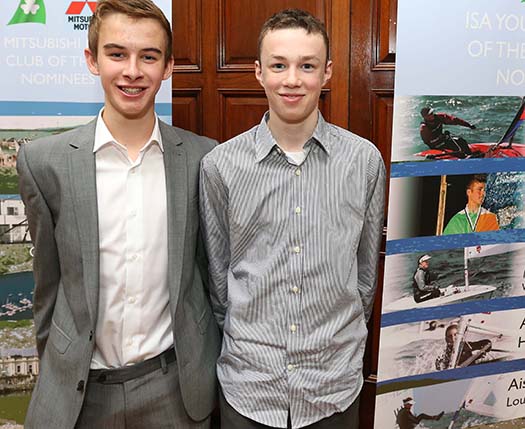
Conor Quinn and Adam D'Arcy

Pat O'Neill and Charles Seargent
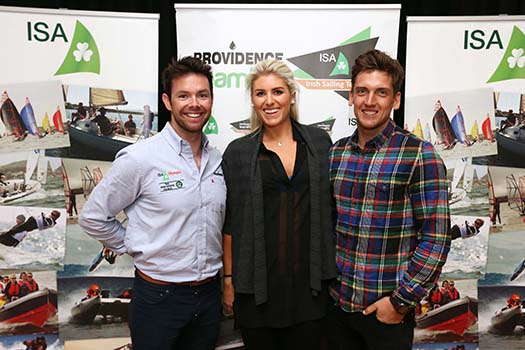
Matt McGovern, Ryan Seaton and Saskia Tidey
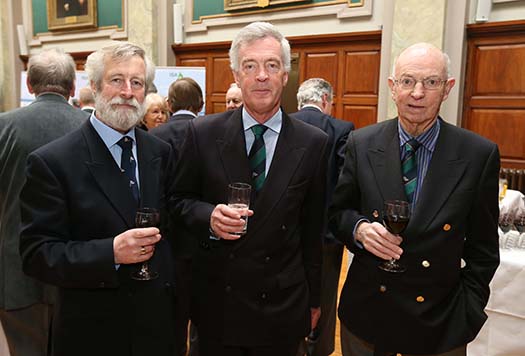
Charles Sargent, Brian Craig and Paddy O'Neill

Jack Roy, David Vinnell, and Ron Hutchieson
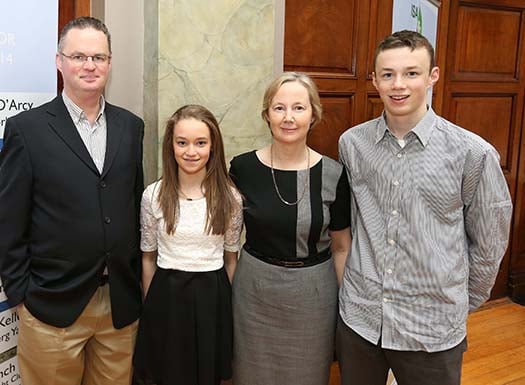
John D'Arcy, Kate D'Arcy, Imelda D'Arcy and Adam D'Arcy
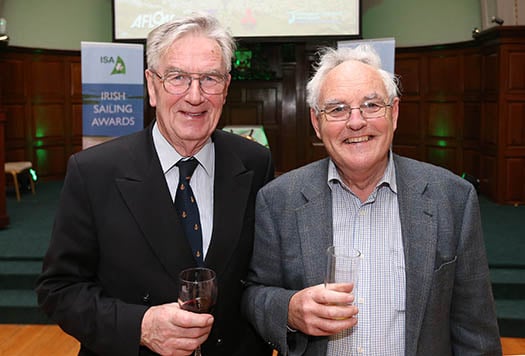
Hal Bleakley and Padraic O Brolchain

Ian Dickson, Andy Johnston, Jim Lampkin and Jane Johnston
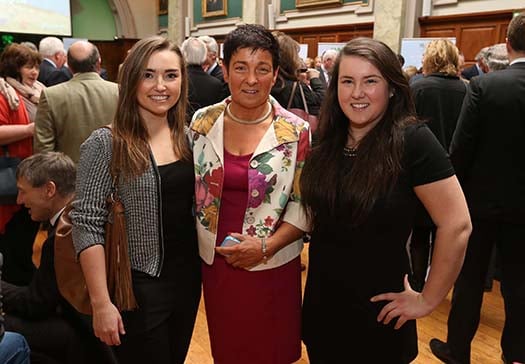
Isabella Morehead, Claire Burke and Muireann Guifoyle

Tony O'Driscoll and David Metcalfe
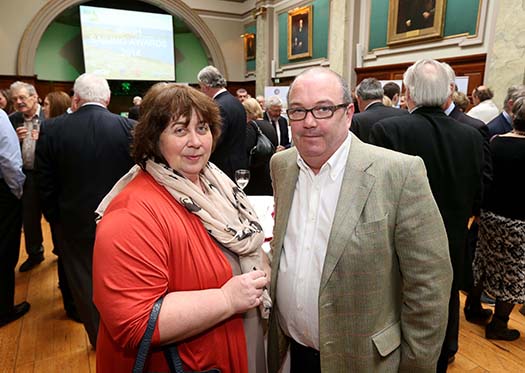
Sandra Wynne and Edwin Fay
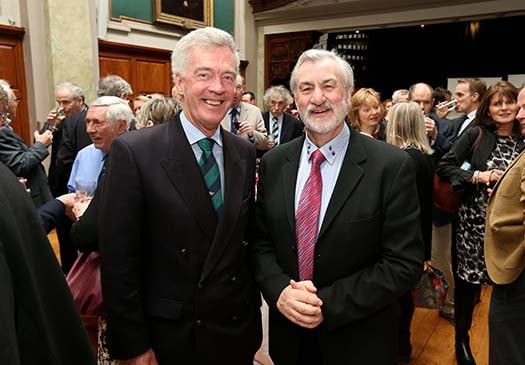
Brian Craig and Kieran Mulvey, Chairman, Irish Sports Council
#soy – The new stars of the Irish sailing firmament are Anthony O'Leary (57) of Cork and the successful Commodore's Cup team. In a gala ceremony in Dublin this afternoon to celebrate the many achievements of our sailors in 2014, O'Leary and his team mates were applauded as the crème de a crème, reflecting his own insistence throughout the exemplary Commodore's campaign that it was only by a close-knit group effort that success could be obtained.
The sharing of the award - presented in a crowded gathering of Ireland's diverse sailing community in the Royal College of Surgeons by Minister for the Marine Simon Coveney on behalf of the Irish Sailing Association and Afloat.ie - proved to be doubly appropriate, as O'Leary himself could not be present owing to a longterm commitment to a week-long sailing campaign currently under way in Florida.
However, his son Rob – a former Sailor of the Month himself - accepted the Afloat.ie Sailor of the Month award for June 2014 on his father's behalf. That award was to celebrate Anthony O'Leary's success in being the overall winner of the British Open IRC Championship.
But after that, his personal achievements continued at a high level throughout the season, as he became the Helmsmans Champion 2014 early in September racing with the J/80s in Howth, and then later that same month he won through to be the 1720 National Champion racing in Baltimore.
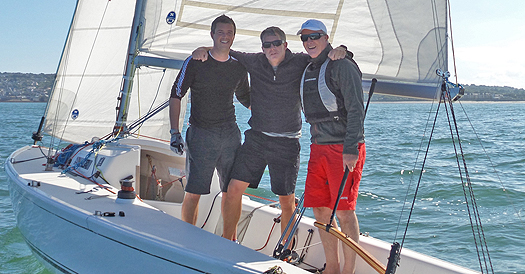
Anthony O'Leary (right) and his crew Dylan Gannon (left) and Dan O'Grady celebrate All Ireland victory off Howth in the Helmsmans Champs. Photo: Jonathan Wormald
That this all occurred within weeks of his brilliant leading of the Commodore's Cup team during the last week of July gives some indication of the enormous contribution made by Anthony O'Leary to Irish sailing during 2014.
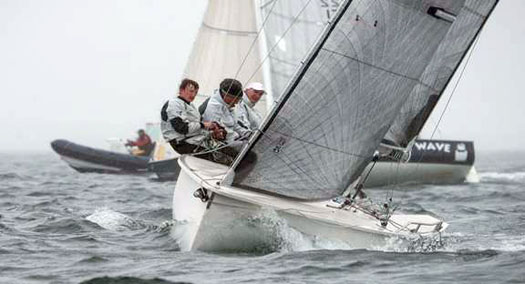
1720 National Champions – Anthony O'Leary's Antix crew in winning form again off Baltimore. Photo: Aedan Coffey
But as the Commodore's Cup win also saw the Afloat.ie International Award for July being made to the entire team, the Sailor of the Year 2014 was jointly presented to Rob O'Leary standing in for his father, and to Michael Boyd, recently elected Commodore of the Royal Ocean Racing Club, who was one of the Irish skippers in the superb Commodore's Cup team.
It is the second time the Crosshaven skipper has won the Irish Sailor of the Year title, he lifted it first in 2010.
Ilen – Uniting Ireland's Coastal Communities Through Educational Endeavour
#ilen – As previously reported by Afloat.ie, the good ship Ilen's whiskey plank was jointly nailed home by Minister For The Marine, Simon Coveney, Mrs Kate Jarvey of Ruth Lily Philanthropic Trust, Mr Gerry Boland of JP McManus Charitable Foundation, Rear Admiral Mark Mellett, the Deputy Chief of Staff of the Defence Forces and Gary MacMahon, director of Ilen School.
Minister Simon Coveney praised the educational model of the Ilen School and the quality of it's community work. He also delighted in the high quality of shipbuilding in the ongoing reconstruction of the good ship Ilen.
As a sailor of wooden boats he related his deep appreciation and enthusiasm for the great traditions of vernacular boatbuilding, and further added that there should be many ships in the style of the Ilen plying a new contemporary trade in community education and national tourism on the south and west coast of Ireland. He also remarked on the unique capacity of boats to unit coastal community – in this particular case the communities of Limerick City and Baltimore, West Cork.
– Over 150 guests attended the ceremony in the Cornstore of Hegarty's Boatyard, leaving little room to swing the custom cast bronze maul.
– Brother Anthony Keane of Glenstal Abbey, director of Ilen School, was MC for the occasion and gave a wonderful and numenious address, evoking the great sea myths of Ireland, and, in the immemorial custom of boatbuilding, doused the wooden hull with Irish whiskey, generously sponsored by Teeling Whiskey.
Michael Byrne of Sail Training Ireland also attended the ceremony – his organisation plan to extend their national sail training programme to include youth in Limerick this year in a joint venture with the Ilen School, and go on to place trainees on the Ilen, when with a fair wind she might enter her operational phase in 2017.
The event was also attended by participants and instructors from the Ilen School, the shipwrights of Hegarty's Boatyard, Oldcourt as well as many officanados from the maritime sphere.
The event was also attended by Tom MacSweeney, who interviewed and recorded the principal project personalities for his maritime radio programme This Island Nation.
Simon Coveney to Nail 'Ilen's' Whiskey Plank at West Cork Ceremony for Ireland's Last Traditional Sailing Ship
#ilen – Simon Coveney T.D. Minister for Agriculture, Food & The Marine and Minister For Defence will hammer home the final 'whiskey plank' of European larch on the hull of the good ship Ilen on Monday, 16th February.
The whiskey plank is the final crafted plank nailed to the hull of a wooden sailing ship. It is a significant milestone in the build and is traditionally marked by a celebration.
The Ilen is the last of Ireland's traditional sailing ships. Built in 1926, it was delivered by Munster men to the Falkland Islands where it served valiantly for seventy years, enduring and enjoying the Roaring Forties, the Furious Fifties, and Screaming Sixties.
Returned now to Ireland and given a new breath of life with powerful ribs of grown Irish oak, and long planks of European larch from our gallant allies in the Bavarian Alps, she pitches impatiently in the trammels of the great Corn Store in Hegarty's Boatyard, as eager as a young salmon to get to the sea.
Tense Whitefish Quota Negotiations Continue
#whitefish – The Minister for the Marine, Simon Coveney TD, took part in 'very difficult' fishing meetings yesterday on the deep cuts to white fish quotas proposed by the Commission which continued late last night.
Early morning meetings continue on difficult negotiations on quota allocations.
The Minister is insisting on a fair deal for Irish fishermen and a responsible science based deal for fish stocks.
The Minister stated that he is refusing to compromise on protecting the livelihoods of fishermen, when there is strong science to back up the Irish position.
There may be agreement late this afternoon / early evening but it is too early to accurately predict according to the Minister.




























